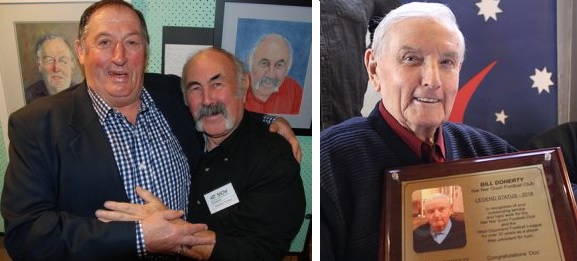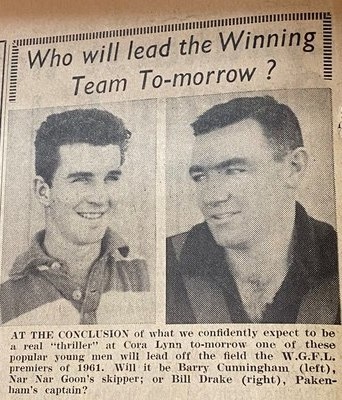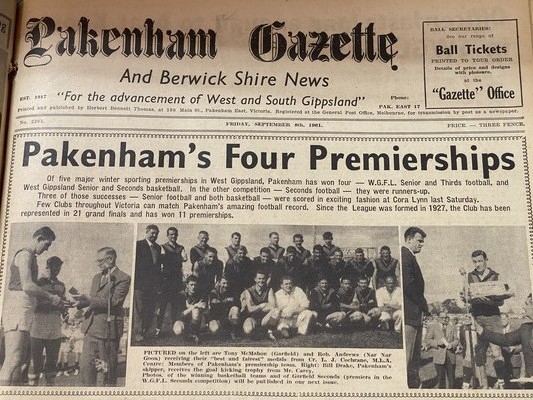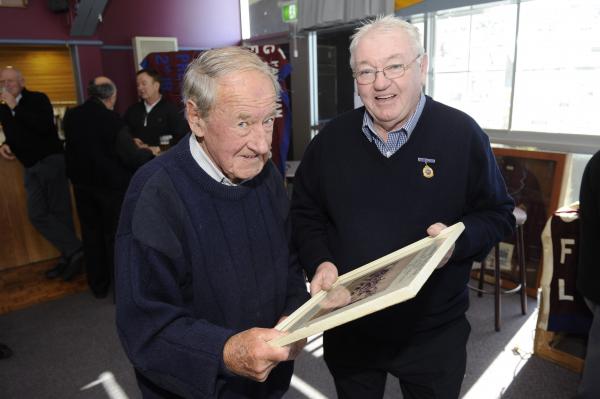
As the growth corridor in Melbourne’s south east has continued to rapidly expand in recent years, areas such as Pakenham – once small, country towns – have seemingly been swallowed up and fast become part of the urban sprawl.
But Pakenham’s rural roots are never too far from the surface, and the same can be said for the heritage of its football and netball club.
Though it seems merely a product of a bygone era in the eyes of many of the younger generation, much of Pakenham’s rich footballing history is intertwined with west Gippsland’s smaller country towns – Kooweerup, Garfield, Cora Lynn, and Lang Lang, just to name a few.
But the Lions’ historic rivalry with Nar Nar Goon still lives strong in the memory of those who saw it unfold, played a part in it, or learned all about it as they grew up.
The two clubs now compete in different competitions entirely, and have for some time, but the tales of their heritage share some truly incredible chapters.
Nar Nar Goon’s 1965 West Gippsland premiership stopped in its tracks a Garfield side that had won two in a row in ’63 and ’64.
And arguably the biggest ingredient in that success was Bill Drake, who they lured as coach from Pakenham in the off-season.
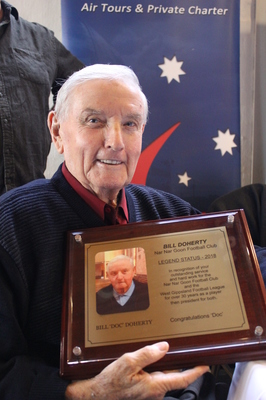
The great Bill ‘Doc’ Doherty has been a legend of the local footy landscape for decades now – even generations.
And in mid-2018, that word – legend – was made official in the esteem that his beloved Nar Nar Goon holds him in.
After originally playing for neighbouring rival Cora Lynn, Doc crossed to Nar Nar Goon and though he was a more than handy footballer, his biggest impact was felt off the field. First elected at just 33, he served as Nar Nar Goon’s president for eight years and the crowning glory of that period was the famous ‘65 flag, when he lured Drake from Pakenham to coach for that one season and, ultimately, break a 28-year premiership hoodoo.
Doc, as the story goes, was about to give the presidency away ahead of the ’65 season. But first he had to find a new coach.
When the club advertised the position, Doc got a phone call from Drake, who suggested he touch base with a bloke from Berwick.
At that time, Drake was widely regarded as West Gippsland’s ‘Mr Football’ – having won two Clancy Medals as the league’s best and fairest player, and coached Pakenham to two flags.
He sensed Doc wasn’t interested in the ‘Berwick bloke’, and he was right.
Doc was only interested in one person for the coaching role – the then coach of Pakenham, Drake.
It’s only fitting that a tale such as this could have the name ‘Doc and Drake’ – given how unforgettable it is.
The two men agreed to have a chat about the vacant coaching role at the Goon, but back in those days clubs weren’t allowed to talk to coaches from other clubs – so the pair agreed to meet at 9pm one night in December at Doc’s house in the Goon.
It was almost midnight by the time Drake signed, and he only did it on the proviso that Doc continued on as president for another year.
This was the local equivalent of the coup that saw Melbourne champion Ron Barassi defect to Carlton in that very same year, and didn’t go down too well in some quarters.
In mid-May of 1965, Drake came up against his former Pakenham team mates for the first time, and while the Goon prevailed by 52 points, he came off second best from a clash with Pat Monckton (who would later go on to make his own move to Nar Nar Goon) – suffering a dislocated shoulder just before half-time. Drake had kicked four goals by that stage.
Later in the year, in the rematch against the Lions, Drake was incredible – booting eight goals in a best on ground effort as the Goon won in a landslide.
He gave the Goon faithful hope that 1965 could be just the start of sustained premiership success, but it wasn’t to be. Drake left the following year to play for Ainslie in Canberra, where in his first season he beat a promising youngster – Alex Jesaulenko – to the best and fairest.
Truly – when it came to the footy – Nar Nar Goon and Pakenham hated each other.
But before the first bounce and after the final siren on game days, they were the same sort of people from the same broader community.
It was their common traits, and togetherness in many ways, that made their rivalry so fierce.
Incredibly, when the Goon came together in 2015 to celebrate the 50-year reunion of the 1965 premiership, their own ground was unavailable – so they held the event at Pakenham, despite the two clubs being in different leagues at that stage.
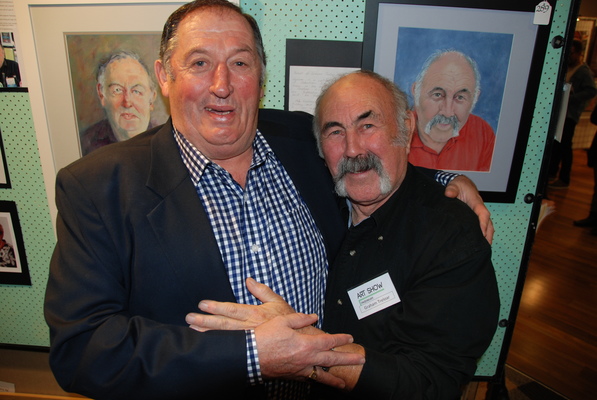
Graham ‘Uncle’ Treloar – Pakenham Football Club icon
‘Uncle’ tells the story of a Pakenham supporter who wouldn’t even buy meat from Claude Gook’s butcher shop in their own Main Street, simply because he had blue and white tiles out the front of the shop – Nar Nar Goon colours.
That’s how deep this rivalry ran.
In the book ‘The Goon – Celebrating 100 years of football (from 1910 to 2010)’, written by Gazette editor and former Nar Nar Goon president Garry Howe, Treloar spoke at length about the rivalry, from his early days in footy in the 1960s.
“The level of rivalry is captured by the following little story,” Treloar wrote.
“A young Pakenham lad broke the news to his parents that he was getting married – and in doing so told them that he had good news, and bad news.
“The good news being that the intended wife was of the same faith (no worries there), but the bad news was that she came from Nar Nar Goon!
“I feel I can safely tell that story, because both my mother and my wife came from Nar Nar Goon.”
But some throughout the generations didn’t quite appreciate the magnitude of what had come before.
“I remember talking to Greg Atkins one day, and he made the comment: ‘I don’t know what you are on about, Uncle, with this Pakenham versus Nar Nar Goon rivalry; I’ve been playing for 10 years now and in 20 games I’ve played against the Goon they’ve never beaten us’,” Treloar said.
Uncle, the long-time figurehead of Treloar’s Hairdressing and Tobacconist, said the rivalry was also great for business.
“Personally, I used to hate it when the Goon beat us, but it was great financially, as everyone in Nar Nar Goon would be down that week for a haircut,” he said.
“If they lost, you would not have a customer from the Goon for a month!”
Before Bill Drake made his highly-publicised switch to Nar Nar Goon for ‘65, he was the central figure in another famous on-field chapter between the two clubs, as Treloar explained.
“In 1961 Pakenham went to Nar Nar Goon for a must-win game for the Lions and our then coach Bill Drake had a broken arm,” he said.
“His arm was in plaster but he was so desperate to play, he wrapped it in bandages and took the field.
“At half-time we were going alright and Drakey was in his usual superb touch. Then the proverbial hit the fan when the Goon players complained and the umpire said Drakey could not continue.”
Treloar said “pandemonium” then broke loose in the Pakenham rooms.
“Drakey wanted to cut the plaster off his arm and continue, but fortunately common-sense prevailed and Pakenham officials stopped him,” he said.
“While all this was taking place, I was petrified because, being 19th man, I would have had to replace the great man.
“All’s well that ends well and, against the odds, we won the game. Then four years later our great coach Bill Drake defied logic and coached the Goon to the 1965 flag. That intensified the existing rivalry to an even greater level.”
Speaking to the Gazette for this story, Treloar spoke about the rivalry dating back as far as the 1930s, and a series of hotly contested clashes – including the 1933 and 1934 grand finals, which Nar Nar Goon won in thrillers.
That period is widely regarded as Nar Nar Goon football’s ‘golden era’, given the club won flags in 1924, 1929, 1930, 1933, 1934, and 1937.
“The rivalry started in the ‘30s and went right through, and every home and home game between Nar Nar Goon and Pakky had a lot of spice in it,” Treloar said.
“I reckon in those days, Nar Nar Goon was probably a bigger town – pro-rata – than it is now. The two towns were probably equal in size then, so they had a great competition.
“There was this to-and-fro in home and home games up to the ‘60s, and we beat them in the ’61 grand final.”
Throughout the ‘60s, Nar Nar Goon and Pakenham clashes were a sight to behold.
During that period, Pakenham, Nar Nar Goon, and of course Garfield shone brightest, and then in 1972 the rivalry between Pakenham and Nar Nar Goon appeared to reach explosive new heights.
“After one of the games, which we played at Nar Nar Goon and lost, that’s when we went to the pub, which was the thing in those days because you didn’t have social rooms, and that was the night the bloody thing blew up!” Treloar said.
“One of the Nar Nar Goon people said ‘they’ve gone too far this time – they’ve blown up our bloody pub!”
Of course, the pub incident was accidental and had nothing to do with Pakenham, but the timing was incredible.
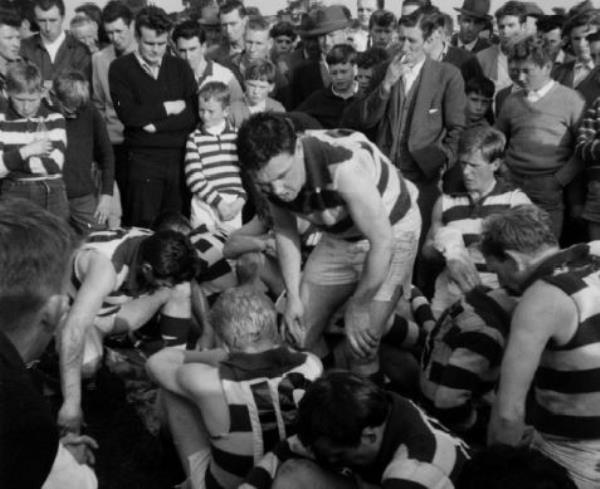
The genuine nature of the on-field rivalry is perhaps best summed up by then Gazette editor Herb Thomas, who was so moved by the sportsmanship displayed by both Nar Nar Goon and Pakenham in the 1961 grand final – which Pakenham won by 19 points – that he wrote in a front page editorial on 8 September: “We’ve seen many football grand finals. Some have equalled, a very few have surpassed the standard of last Saturday’s match at Cora Lynn; but the majority have fallen far short of this grand final as far as play goes.
“In one respect too, it stands on its own. We’ve never known a grand final where there has been such a nice feeling and genuine goodwill existing between the rival sides; before, during, and after the game.
“On the field the teams played hard but always perfectly clean football; which is exactly how it should be, for football is a ‘man’s game’. But when the match was over there was a stream of players and officials between the rival rooms – Nar Nar Goon representatives congratulating Pakenham on a meritorious win; Pakenham players and officials commiserating with Nar Nar Goon. And what’s more important, the nice things said were really meant by both sides.
“While this spirit exists, football in West Gippsland must go from strength to strength. Hats off to all concerned for a demonstration of that true sportsmanship on which we Australians pride ourselves.”
Treloar spoke about the feeling of anticipation every time Pakenham and Nar Nar Goon faced off.
“You’d always look forward to the games against Nar Nar Goon, and you’d always dead-set want to beat them – and they were the same to us, so that’s why it was so great for my business if Nar Nar Goon beat us because all those Nar Nar Goon people would want to come in for a haircut,” he said.
“The players and supporters would give me plenty of curry.
“But if Pakenham won, it wasn’t great for business that week because the Goon people would stay away.
“It’s hard to explain just how fierce the rivalry was back then – even in the seconds and thirds.”
While the rivalry continued for decades after, particularly in the eyes of the older generation, Treloar explained that the younger brigade, including the likes of Greg Atkins and Mark ‘Spud’ Carney, formed great mateships with their opposing clubmen.
“They didn’t quite have the rivalry then that we used to when I started playing, but they’d have a love-hate relationship. There were good mates on both sides, and then when the weekend came, it was on,” Treloar said.
“One of the reasons why the rivalry was so good was that they were the two closest towns, geographically, and a lot of the people who lived on, say, Bald Hill Road or the highway between Pakenham and Nar Nar Goon, would go to either club.
“Cecil Andrews was another who went from Pakenham to Nar Nar Goon, and he played for years with them – he lived out at Nar Nar Goon North.
“He was a top player, and he ended up shifting into Pakenham – just opposite the footy ground.
“I chased his son, Cecil Jr, for year after year to come and play for Pakenham, but he just wouldn’t. The family had a bit of a foot in both camps though.”
Over the years, the demographics of the two towns have seen the football clubs head in opposing directions.
“But back in the day, Pakenham and Nar Nar Goon games just went up another level,” Treloar said.
“When Pakenham played against Nar Nar Goon, that was the best gate for the year, and Bill (Doherty) would say the same thing – as soon as you got the draw, you’d look to see when Nar Nar Goon and Pakenham would play.
“That gate would almost double – it had that genuine pulling power.”
Casting an eye over the competitions Nar Nar Goon and Pakenham now play in, Treloar wishes the two clubs could still be in a position to play against each other.
“It’d be great, but in reality Pakenham would be a bit too strong now,” he said.
“Back when we opened the old social rooms up in 1982, we left that for a day we were playing Nar Nar Goon because we knew the crowd that’d turn up.”
Dan O’Loughlin – four-time Pakenham Football Club premiership winner, four-time league best and fairest winner
O’Loughlin is Pakenham through and through… or so most people think.
He was born in Nar Nar Goon, and his dad Steve – who milked cattle in the town on the family farm – played for the club.
“Dad informs us that he was the best player to ever wear the number 63 for Nar Nar Goon,” he said with a laugh.
“There really is a family history with the Goon – both in the community, and when it comes to the footy.
“The rivalry started well before I got to the club (Pakenham). It was very much passed down to us from blokes like the ‘Spud’ (Mark) Carneys, who ended up being an integral part of the Nar Nar Goon footy club later on.
“Mick Keane went on to be president when they won the flag in 2010, and he was the Pakenham president when we won the flag in ‘98 too.
“I use ‘hatred’ as a loose term to describe Nar Nar Goon, really. It wasn’t hatred, because – socially – we really were thick as thieves.”
But whenever the two clubs came together on-field, it was on.
“It didn’t really matter where the clubs were on the ladder – it was on, whenever they played,” O’Loughlin explained.
“Nar Nar Goon would build it up as their grand final every year – if they weren’t going to make the finals, they knew playing Pakenham – and beating us – was the next best thing.
“And to their credit – and this still doesn’t sit too well with most Pakenham people – in the last game we played at the old ground in the town centre, in the mid-1990s, we played the Goon and they beat us by a point.
“God some of the old Pakenham people were so dirty on us for losing that one. How could we allow it to happen?”
O’Loughlin said the fact that the Pakenham and Nar Nar Goon groups got along so famously off the field meant that the on-field rivalry meant even more.
“It wasn’t necessarily physical – Pakenham certainly wasn’t known for its physicality in my time. It was just a pure football rivalry – they lifted to the occasion, and a lot of the time we just couldn’t take it up to them.”
O’Loughlin loved hearing about the rivalry’s early chapters – featuring the likes of Bill Drake.
“I remember hearing some of the stories that poor old Bill copped it from the Pakenham people when he went across to the Goon, but in modern times blokes like ‘Jock’ (Michael) Holland, ‘General’ (Dean Blake), and ‘Mitsu’ (Phil Anning) have gone out there too,” he said.
“It’s unbelievable, that. If you had’ve told me in my playing days that’d happen one day, particularly with those three, I would have said you were bloody crazy!”
The south-east has changed markedly from the heyday of the Pakenham and Nar Nar Goon rivalry, and O’Loughlin said he still misses the country feel of the old West Gippsland days.
“I think you’d find now that a lot of the old Pakenham supporters – to some degree – would be following Nar Nar Goon in the West Gippsland competition,” he said.
“It’s just a bit of a shame that suburban footy doesn’t quite have that same connection that the country community has.
“Saturday was a full day with the family at the footy – you’d take the car there at 9am and you were generally there until nine or 10 at night. It was a full day of community entertainment.
“It’s really pleasing that we got to experience what it was like when Nar Nar Goon and Pakenham went head-to-head. That’s something I’ll be forever grateful for, and I still absolutely love running into the likes of (former Goon champion) Nick Collins. They’re just quality people.
“On the field it was game on, but socially they’d be the first people to put a beer in your hand and make sure you were well looked after in their company.”
In the modern era, two names – in particular – come to mind for O’Loughlin when he thinks of the rivalry.
“Mick Keane and Mark Carney are definitely the two that come to my mind – they went there (to Nar Nar Goon) post-football and had an involvement in more than just socially going to the footy,” he said.
“They were both on the committee, and Mick was the president there – and is again now.
“Spud (Carney) coached Pakenham and then went on to the committee at the Goon, and Mick was president of both clubs – in 1998 when I won my first premiership, which was played at Nar Nar Goon because Cora Lynn’s ground wasn’t up to it that year, and then in 2010 at Nar Nar Goon.
“Socially, you just can’t fault the Goon. The banter between the two clubs was sensational, and the Nar Nar Goon pub, as an 18-year-old on a Saturday night, was seriously the place to be.”
From O’Loughlin’s perspective, the current day footballer rising through the ranks is a completely different breed to back when he played. It’s not a fault of theirs – it’s just the reality.
“Players have changed, for sure. I don’t think they necessarily crave what we did,” he said.
“We absolutely wanted the respect of the elder statesmen back in the day. We couldn’t wait until after the game when we could maybe meet a Nick Collins and be in the same conversation as him.
“The younger players are so much more confident now, but they don’t crave that as much as we did. That’s fine – it’s just different.
“Back when we were coming through, we were told that the first thing you do in another club’s rooms is look on their honour boards to pay respect to the people from that club.”
And O’Loughlin misses the days when community footy – even from Monday to Friday – was truly king in the local area.
“I held a job in retail where you’d see a lot of people, so you couldn’t escape the footy if you tried,” he said.
“Leading up to a Saturday game against Nar Nar Goon, anyone you’d bump into from the Wednesday to the Saturday would talk to you about the footy – who’s in or out of the side, who’s injured, the lot. Everything led up to that Saturday at 2pm.
“But working for (Pakenham Football Club life member) Darrell Hardy for 21 years, I know he was extremely clever at remaining neutral when it came to the footy and not putting anyone offside. As a businessman, that’s something he was very respectful of.”

Stan Young – Pakenham Football Club icon, and former long-time publican at ‘Purvies Pub’ (now the Drake Tavern)
As a youngster in his formative footballing years, Young got to witness the greatness of Bill Drake up close.
He even called him “a kind of second father figure” at Pakenham.
“The year he went to Nar Nar Goon was my first year of senior footy – in 1965,” Young explained.
“He was just sensational. You see a lot of good players getting around, but he was the sort of player who could genuinely win you a game off his own boot.
“He stood out in the big games – he was a marvel, and in that era, I rate him as the best I saw.”
That front-row seat gave him his own perspective on the famous Goon versus Pakenham rivalry.
“Being neighbouring clubs, there was always a fantastic rivalry,” Young said.
“When I was playing in the thirds, the old rivalry in the seniors had a lot of money change hands over betting on the game.
“The late Dan Cunningham would organise the Nar Nar Goon boys, and Gavan Bourke was usually the one to collect the money for the Pakenham boys.
“There was always a fair bit of wagering going on, so they definitely played for keeps.”
And, clearly Drake’s move to the Goon escalated things dramatically.
“Mr Doherty hastened the rivalry when he poached Billy Drake back in ’65 – he was sneaking around after dark with a bag of money!” Young said, with tongue firmly planted in cheek.
“Billy was a true champion of the game in West Gippsland and he was a big loss when he went to Nar Nar Goon.
“They played for keeps and there were a few blues now and again, but when the siren went that was it – they shook hands, and it was into the pub for a beer.
“Even though there was a great rivalry, back in those days you’d always head back to the hotels after the game – either to Nar Nar Goon, or Purvies.”
According to Young, his old mate ‘Doc’ has even more to answer for when it comes to the rivalry.
“Mr Doherty also caused more trouble when we beat Nar Nar Goon on a very wet day at Pakenham and he declared our ground a cow paddock!” he said, laughing.
“That didn’t go over real well with the hierarchy at Pakenham, put it that way.
“Mr Doherty has a lot of the responsibility of that rivalry!
“But, on a serious note, he’s just so highly admired for what he’s done for football in the area, and what he means to so many people.
“Personally, I still love going back to the old West Gippsland clubs because they’re most of the clubs I played my footy against. I love going back to have a beer with a few of my mates from way back.”
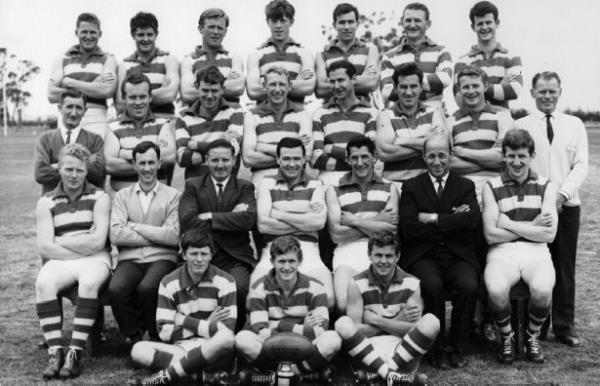
Mick Keane – current Nar Nar Goon president, former Pakenham president
Keane’s involvement at Pakenham first started when he took over as treasurer in the early 1980s, and escalated once his boys joined the fold as junior players at the Lions.
“I was playing there – a lot of my mates were playing at the club too – but I think I only played one year in the reserves,” he explained.
“That was back in the days of the 19th and 20th man and I was a very, very, very ordinary footballer. At the end of 1982, I think the coach at the time – Rod Walker – told me I might be better off in an administration role!”
To put it simply, Keane saw his point.
And in the years since, he served as treasurer, secretary, and then president in a premiership-winning era for the Lions.
“The gap between what Pakenham has become, and the smaller towns like Nar Nar Goon and Garfield, has just continued to grow,” Keane surmised.
“Those smaller towns just weren’t growing at the same rate, obviously, and we were able to capitalise on that as a club and had so many young players coming through the doors.”
One such player that springs to mind is Tim Cantwell.
“He became one of our best full-backs – a tall, skinny beanpole – and he left Pakenham and went out to Catani for a few years,” he said.
“He came back a better footballer, and played really well at Pakenham after that too.”
Keane then brought up the curious story of Pakenham signing a player by the name of Webster from Nar Nar Goon.
“Of course, all the people at Pakenham were rubbing their hands together because they thought they had (1980 premiership player) Geoff Webster.
“It turned out they hadn’t signed Geoff at all – they’d signed his brother Brian, or ‘Worm’.
“That wasn’t ideal for them, because Brian was probably more like me as a player than Geoff!”
So, that doesn’t exactly make up for the real coup in 1965 – Drake to Nar Nar Goon.
Keane also spoke of what would have been a sliding doors moment when ‘Spud’ Carney very nearly joined the Goon – as a player.
“He came to me in 1990 and said he had the Pakenham (coaching) job or the Nar Nar Goon one.
“I told him to go to Nar Nar Goon because he was on a hiding to nothing at Pakenham – they’d won four in a row!
“In the end, he stayed at Pakenham and only coached the one season.”
Keane’s sons, Ben and Matt, started their footy careers at Pakenham before ultimately making the switch to the Goon and winning the 2010 senior EDFL flag over Cora Lynn. Keane was the president at the time.
In fact, the likes of Brodie Howe, Adam Marchant, and even former skipper Brent Hughes initially came from Pakenham as well.
Having long been part of the fabric at the Goon, Keane loves the genuine country footy feel that still exists around the club.
“Just being able to stand around the fire, have a beer, and have a chat – I love that,” he said.
“Some people whinge about going home smelling of smoke … please.”
It was in about 2004 when Nick Collins called Keane to first ask if he’d join the committee as treasurer.
He served in that role for four years, had a season off, and was the president in 2010 when the boys from the Goon held the premiership cup aloft – breaking a 30-year hoodoo.
Keane spoke of the feeling around the club at that stage.
“It meant a lot more, because at Pakenham I took over as president for 1997, ’98, ’99 and I was told I had a bit of a task on my hands – at that stage it was the only decade in the history of the Pakenham Football Club that it hadn’t won at least two premierships,” he explained.
“We won in 1990 and hadn’t won one up until 1998.
“But at Nar Nar Goon it’d been 30 years. It was a very different feeling – particularly when you put that season into perspective, with the centenary celebrations and the flag on top of that. The side was similar to Pakenham’s in 1998 in that a lot of the players were young locals, but it was just such a special feeling.”

